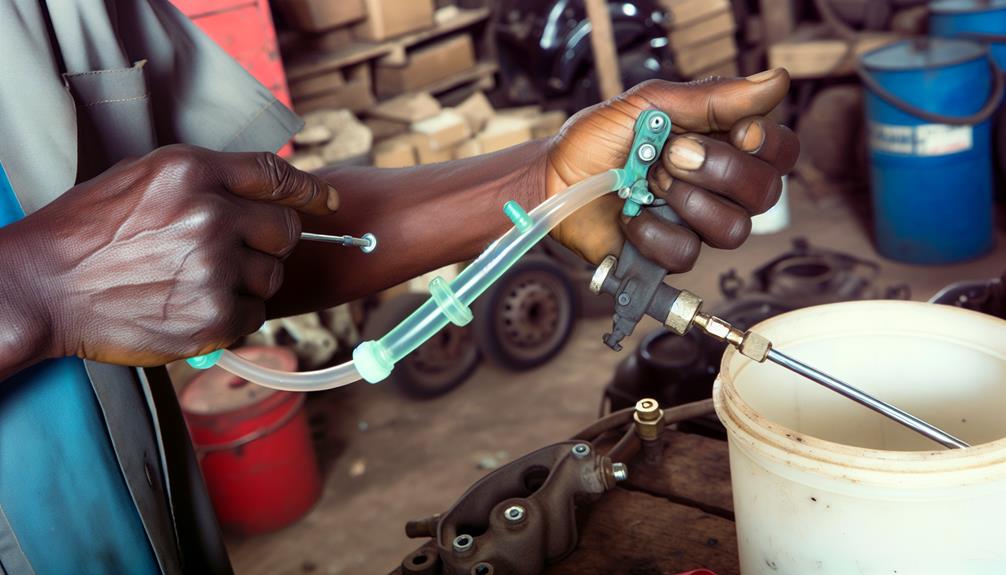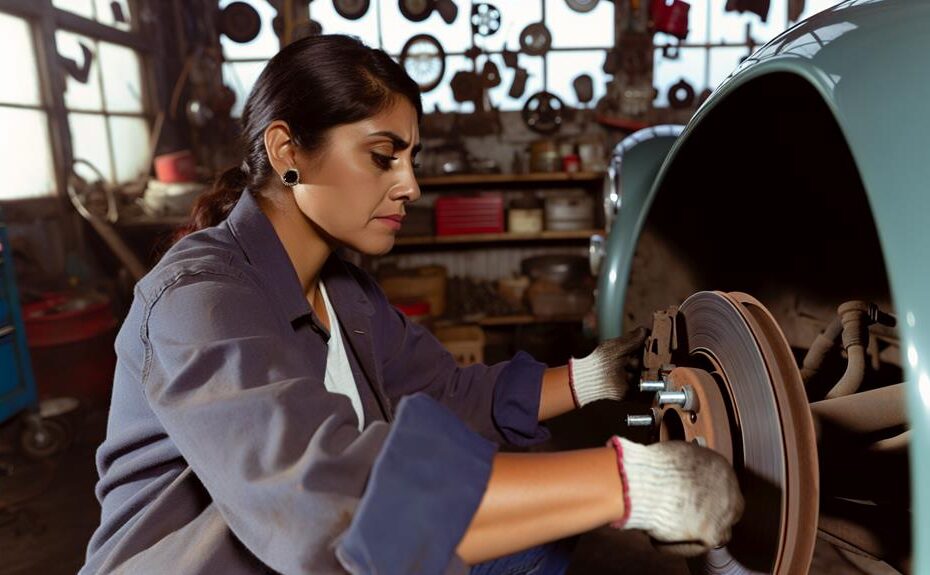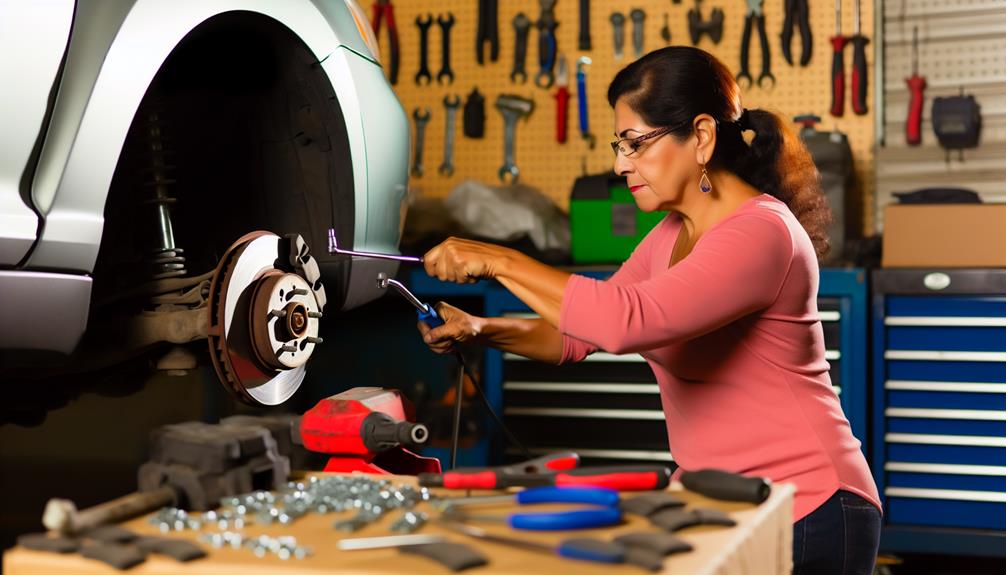Have you ever wondered how to properly maintain and repair the brakes on older cars and vintage vehicles? The truth is, these classic beauties require a different approach when it comes to brake repair. With their unique design and aging components, it's essential to have a solid understanding of the best practices for keeping their brakes in top-notch condition.
In this discussion, we will explore some of the best brake repair tips specifically tailored for older cars and vintage vehicles. So, if you're ready to ensure the safety and performance of your beloved classic ride, buckle up and let's dive into the world of brake maintenance for vintage vehicles.
Key Takeaways
- Regular inspection of brake components is essential for identifying signs of wear and potential problems in older cars and vintage vehicles.
- Uneven pad wear, excessive brake dust, decreased braking performance, and unusual noises or vibrations are indicators of brake wear and issues.
- Choosing the right brake pads, such as ceramic ones, can provide superior braking performance, less noise, and less brake dust.
- Proper maintenance of brake fluid, including regular inspections and flushes, is crucial to maintain optimal braking performance and prevent brake failure.
Signs of Brake Wear
To identify signs of brake wear, carefully inspect your older car or vintage vehicle for visible indicators such as uneven pad wear, excessive brake dust, or a noticeable decrease in braking performance. These are common brake problems that can occur over time due to regular usage and wear and tear. Uneven pad wear is often a result of a misaligned brake caliper or uneven pressure distribution on the brake pads.
Excessive brake dust can indicate that the brake pads are wearing down quickly and may need to be replaced soon. Finally, if you notice a significant decrease in braking performance, it could be a sign of worn-out brake pads or a problem with the brake fluid.
When it comes to brake repair cost estimation, it's important to consider the specific issues affecting your vehicle. Brake repairs can range from simple pad replacements to more complex repairs such as replacing the brake rotors or calipers. The cost can also vary depending on the make and model of your car, as well as the labor rates in your area. It's advisable to consult with a professional mechanic to get an accurate estimate for your specific brake repair needs.
Choosing the Right Brake Pads
When selecting brake pads for your older car or vintage vehicle, it's crucial to choose the right ones that meet the specific requirements and performance needs of your vehicle. Brake pads are an essential component of the braking system, responsible for generating the friction needed to stop the vehicle. There are various types of brake pads available in the market, each with its own advantages and disadvantages.
One of the most common types of brake pads is the organic brake pad. Made from a mixture of organic materials such as rubber, carbon, and Kevlar, these pads provide good stopping power and are relatively quiet. However, they tend to wear out faster and can produce more brake dust.
Another option is the semi-metallic brake pad, which contains a mixture of metal fibers and other materials. These pads offer excellent stopping power and are more durable than organic pads. However, they can be noisier and may cause more wear on the brake rotors.
Ceramic brake pads are another popular choice. These pads are made from ceramic fibers, filler materials, and bonding agents. They offer superior braking performance, produce less noise, and generate less brake dust. However, they can be more expensive than other types of brake pads.
Once you have selected the right type of brake pads for your vehicle, proper installation is crucial. It's recommended to have a professional mechanic install the brake pads, as they have the expertise and tools to ensure a proper fit and performance. Incorrect installation can lead to brake noise, reduced braking efficiency, and even brake failure.
Proper Brake Fluid Maintenance

Proper maintenance of the brake fluid is essential for ensuring optimal performance and safety of your older car or vintage vehicle. Brake fluid plays a crucial role in the braking system by transferring the force applied on the brake pedal to the brake calipers, which then apply pressure on the brake pads to stop the vehicle. Over time, brake fluid can become contaminated with moisture, dirt, and debris, which can compromise its effectiveness. To maintain the integrity of your brake fluid, regular inspections and a brake fluid flush are necessary.
During a brake fluid flush, the old fluid is completely drained and replaced with fresh fluid. This process helps remove any contaminants that may have accumulated in the system. It is recommended to flush the brake fluid every two years or as advised by your vehicle manufacturer. Neglecting to flush the brake fluid can lead to brake fade, reduced braking performance, and even brake failure.
To help you understand the importance of brake fluid maintenance, here is a table outlining common brake fluid contaminants and their potential effects:
| Contaminant | Effect |
|---|---|
| Moisture | Reduced boiling point, decreased braking efficiency |
| Dirt and debris | Accumulation in brake lines, potential blockage |
| Brake fluid breakdown | Reduced lubrication, increased wear and tear |
Inspecting and Adjusting Brake Calipers
Inspecting and adjusting brake calipers is an important aspect of maintaining the performance and safety of your older car or vintage vehicle. It ensures that the braking system operates smoothly and effectively. Brake calipers play a crucial role in the braking process by applying pressure to the brake pads, which then clamp down on the brake rotors to slow down or stop the vehicle.
Over time, brake calipers can develop issues that affect their functionality. One common problem with brake calipers is sticking or seizing. This occurs when the caliper piston becomes rusted or corroded, preventing it from moving freely. Sticking calipers can cause uneven brake pad wear, reduced braking power, and potential damage to the brake rotors. Regular inspection of the calipers can help identify any signs of sticking or seizing early on, allowing for necessary adjustments or replacements.
Another common issue is brake caliper leaks. Leaking brake fluid can contaminate the brake pads and rotors, leading to reduced braking performance and potential safety hazards. Inspecting the calipers for any signs of fluid leaks, such as wet spots or fluid accumulation, is crucial for identifying and addressing this problem promptly.
To inspect and adjust brake calipers, start by visually examining them for any signs of damage, corrosion, or leaks. Ensure that the caliper bolts are properly tightened and secure. If you notice any abnormalities, it may be necessary to replace the caliper or perform further adjustments. Additionally, check the brake pads and rotors for wear and replace them if necessary.
Regular inspection and maintenance of brake calipers will help keep your older car or vintage vehicle operating safely and efficiently.
Tips for Bleeding Brake Lines

To effectively bleed brake lines, follow these essential tips for maintaining proper brake function and ensuring your vehicle's safety. Bleeding the brake lines is a crucial maintenance task that removes air bubbles or contaminants from the brake fluid, preventing spongy brakes and ensuring optimal braking performance.
Here are some bleeding techniques and common brake line issues to be aware of.
First, start by gathering the necessary tools: a clear plastic tube that fits snugly over the brake bleeder valve, a container to collect the old brake fluid, and a wrench or socket to open and close the bleeder valve. Begin the bleeding process by locating the brake bleeder valve on each brake caliper or wheel cylinder.
Next, enlist the help of an assistant to pump the brake pedal several times and hold it down while you open the bleeder valve. This will allow any air or contaminants to escape through the valve and into the collection container. Remember to close the valve before your assistant releases the brake pedal. Repeat this process for each brake caliper or wheel cylinder, starting from the farthest wheel from the master cylinder and moving towards it.
During the bleeding process, be mindful of the brake fluid level in the master cylinder reservoir. It should be regularly topped up to prevent air from entering the system. Additionally, keep an eye out for any signs of leaks or damaged brake lines, as these can affect the effectiveness of the bleeding process and compromise your vehicle's safety.
Frequently Asked Questions
How Often Should I Replace My Brake Pads on an Older Car or Vintage Vehicle?
You should replace your brake pads on an older car or vintage vehicle when they are worn down to about 1/8 of an inch. Regularly check and maintain brake fluid levels to ensure optimal braking performance.
Can I Use Any Type of Brake Fluid for My Older Car or Vintage Vehicle?
You should be aware of compatibility issues when choosing brake fluid for older cars and vintage vehicles. Not all types of brake fluid are suitable, so it's important to use the right one to ensure optimal performance and safety.
Is It Necessary to Replace the Brake Calipers on an Older Car or Vintage Vehicle?
You should consider replacing the brake calipers on your older car or vintage vehicle. Over time, calipers can wear down and impact braking performance. It's important to ensure your brakes are in top condition for safety.
Are There Any Specific Safety Precautions I Should Take When Bleeding Brake Lines on an Older Car or Vintage Vehicle?
When bleeding brake lines on an older car or vintage vehicle, it is crucial to prioritize safety precautions. Ensure you have the proper tools, wear protective gear, and follow the manufacturer's instructions to avoid accidents and maintain your liberation on the road.
What Are Some Common Brake Issues That Are Unique to Older Cars or Vintage Vehicles?
Common brake issues in older cars or vintage vehicles include rusted brake lines, worn brake pads, and deteriorated brake hoses. To maintain and preserve the original braking system in vintage vehicles, regularly inspect and replace worn components.
Conclusion
In conclusion, taking proper care of the brakes in older cars and vintage vehicles is essential for their performance and safety.
By being attentive to signs of brake wear, choosing the right brake pads, maintaining brake fluid, and inspecting brake calipers, you can ensure the longevity and efficiency of your brakes.
Remember, just like a well-tuned orchestra, a well-maintained brake system harmoniously keeps your vehicle in control and brings it to a smooth stop when needed.
- How to Close Spark Plug Gap: Expert Tips and Tricks! - May 13, 2024
- How to Perfectly Align Projector Headlights With Halo - May 13, 2024
- How Many Amps Does a Car Horn Draw? Unveiling the Power Requirements - May 13, 2024


